What Causes Dog Lameness?
(FTC Disclosure: If you make a purchase via a link on this page, I may receive a small commission, at no added cost to you.)

Overview
Occasionally, we may see our dog limping - maybe due to a cut on the paw pad, a bruise, or a torn muscle...
Lameness means a dog is unable to fully and painlessly move or use a limb, or to put weight on a limb due to pain and discomfort.
Most of the time, lameness in dogs is temporary. The dog may be limping for a day or so, and then he gets better. But if the lameness lasts longer than two to three days, then it is time to visit the vet.
What Causes Sudden Limping in Dogs?
Sudden limping in dogs is usually caused by the following:
Paw Injuries
If you dog is limping and is constantly licking one of her paws, it may suggest that she has sustained some kind of injury to her paw, e.g. a cut or maybe a foreign object is lodged between the toes. Take a look at her paw to see if you can find anything unusual.
Broken Toenail
Sometimes a dog limps when one of his toenails is broken as it is painful!
The dog may try to lick or even bite off the loose piece of nail. Again, if your dog limps and licks his paw, be sure to take a good look to see if you can find any broken toenail.
Bites from Insects or Animals
Another reason that causes a dog to suddenly limp is being bitten by an aminal (another dog, a snake, etc.) or bitten or stung by an insect.
If you suspect your dog has been bitten, see if you can find any puncture wound on your dog's limb.
Tick-borne disease (Lyme Disease) can also cause sudden lameness in dogs. If your dog has been out playing where ticks frequently hang out (e.g. tall grass), be sure to check the dog all over to see if you can find any ticks on his body.
Bone Fractures
Bone fractures are another common cause of dog limping. A dog may get a bone fracture after being hit by a car, for example, and fractures can happen to almost anywhere in the leg or hip. Bone fractures can range from just slight cracks in the bone to complete shattering of the bone into fragments.
Ruptured Ligament
A ruptured ligament in the knee joint can also cause a dog to limp. Young dogs who exercise a lot can quite often suffer from this problem. You may be playing frisbee with your dog when suddenly he slips and then starts limping.
What Could Cause Chronic Limping in Dogs?
Here are some common reasons that cause chronic limping in dogs:
Kneecap Dislocation
 If you have a small or toy breed dog (e.g. Chihuahua, Yorkie), and if your dog is limping on and off, he may be suffering from a condition called "Luxating Patella", or kneecap dislocation.
If you have a small or toy breed dog (e.g. Chihuahua, Yorkie), and if your dog is limping on and off, he may be suffering from a condition called "Luxating Patella", or kneecap dislocation.
This condition causes the kneecap to sometimes move sideway and the dog cannot bend his leg. After a while, the kneecap may suddenly slide back into position and the dog can walk normally again.
When the kneecap is dislocated, the dog may be reluctant to bear weight on the affected limb, resulting in lameness. Sometimes, the dog may limp but doesn't seem to have any pain.
Arthritis and Hip Dysplasia
Arthritis can also cause limping in dogs. Arthritis can occur in almost any joint but is common in the hips, along the spine, and in the knee joints.
Hip dysplasia is one common form of arthritis. It refers to the abnormal growth or development of the ball and socket joint of the hips of dogs.
A typical telltale sign of arthritis is the dog will have difficulty getting up after lying down for a while. When he walks after getting up, he will be stiff, sore, and limping.
Hypothyroidism
One possible symptom of hypothyroidism (not enough thyroid hormone) in dogs is severe joint pain, causing the dog to limp.
If your dog is limping and if he is showing some other symptoms such as weight gain, recurrent skin and ear infections, cold intolerance, and lethargy, be sure to get your dog to the vet and ask him to check out the dog's thyroid hormone levels.
Panosteitis
Panosteitis (aka "long bone disease," or "pano") is another canine health issue that causes lameness.
Pano usually occurs in growing puppies (especially large breed puppies) between the ages of five and 12 months. It is a result of excessive bone production on the long bones of the front and hind legs, causing inflammation and lots of pain.
The condition may affect more than one leg bone at a time, or may move from one leg to another. So, you may see your puppy limping on one leg today, and several days later he may be limping on another leg.
Usually a puppy with this condition will grow out of it by 18 months old.
Tumors
A more serious condition that can causes lameness in dogs is tumors in the bones or the central nervous system. Bone tumors can be nasty and usually amputation of the affected limb is necessary.
Limping in Dogs and Their Ages
Though not always the case, generally speaking, limping in puppies is most often caused by injuries or the result of some growth defects or problems (e.g. hip dysplasia, pano).
In adult dogs, lameness is frequently the result of injuries or the onset of arthritis.
In older dogs, degenerative joint disease (DJD) or arthritis and sometimes hypothyroidism are the most common causes of lameness.

Signs of Dog Lameness
- Obvious limping or walking with one leg off the ground.
- Crying and whining out of pain.
- Reluctance to perform normal activity, like going up or down stairs.
- Reluctance or refusing to put any weight on a leg.
Natural Remedies to Help a Limping Dog
As dog limping is not a disease in itself but is a sign of some underlying physical problem, a proper diagnosis is essential in order to identify and treat the root problem.
In the meantime, some natural remedies can be used to alleviate the discomfort and pain that is causing the dog to limp.
Homeopathic Remedie
Homeopathic remedies are extremely effective in relieving pain. Common remedies for pain include:
- Arnica - for muscle pain, strains, sprains and other blunt traumas that result in bruising
- Ledum - for puncture wounds such as insect bites and stings
- Pulsatilla - for arthritic pain
- Rhus tox- for swellings and joint pain
A Good Homeopathic Remedy for Pain Relief
Flower Essences
Flower essences are also effective in alleviating both acute and chronic pain.
An Effective Flower Essence Product for Pain Relief
It contains arnica, Impatiens, and other natural flowers and can be used for cuts, bruises, chronic pain, congestion, recovering from injury and surgery.
Herbs
Various types of herbs can also be used to relieve pain with good results. Please refer to this page for more information.
ReferencesEldredge, et al. Dog Owner's Home Veterinary Handbook 4th edition (Wiley Publishing, 2007).
C.J. Puotinen, Natural Remedies for Dogs and Cats (Keats Publishing, 1999).
M. Goldstein, The Nature of Animal Healing (Ballantine Books, 2000).
R.H. Pitcairn, The Complete Guide to Natural Health for Dogs and Cats (Rodale, 2005).
D. Hamilton, Homeopathic Care for Cats and Dogs (North Atlantic Books, 1999).





